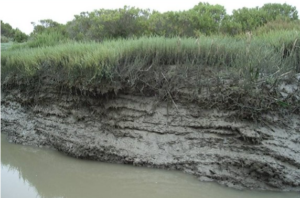
The secret is in the soil

When you look out across a salt marsh, what do you see? Perhaps you look to the water to see oyster beds and juvenile fish swimming-about. Or to the tall grassy marsh plants to see the many species of herons and other birds that find protection and food there. But when I look across these coastal horizons, I look down, beneath the tall grasses, beneath the footprints left by herons, beneath the beds of oysters….down to the mud.
As a kid growing up in South Carolina, our field trips often involved trekking out to the salt marsh. I remember the salty, sweet, sulfur smell and seeing Great Blue Herons flying across the sky. But most of all, I remember getting stuck in the mud. “Pluff” mud is what we called it, and it was the kind that would suck you in if you weren’t careful! You could lose your shoes and your socks in that thick mud. (One kid even lost his pants! But that’s a story for another day…) I never imagined then that years later I would end up looking at that mud so differently, understanding all of the benefits provided deep in soil, and working to protect and restore it.
Because it’s in that gray-brown, muddy soil where all the magic happens: pollutants are filtered out, improving water quality; excess water is absorbed like a sponge, reducing flooding during storms; and, on top of all this, vast amounts of carbon are stored. In fact, coastal wetlands hold SO much carbon, that it got its very own name – Blue Carbon.
As it turns out, wetland marsh grasses and other plants are very good at capturing carbon from the atmosphere (during photosynthesis) and storing it in the ground. Wetland plants can capture carbon 10 times faster than forest, and bury it in the ground at rates 4 times faster.
So wetlands are not only important for mitigating the impacts of climate change by protecting our shorelines from storms and flooding; but they are also taking up carbon from the atmosphere and storing it underground. And as that carbon is buried, wetland habitats can build up (accrete) over time, centimeter after centimeter, layer after layer, which can also help wetlands adapt to rising sea levels.
Just a single meter of that mud can equal hundreds to thousands of years of carbon stored away! And that carbon stays locked up in the ground as long as the habitat remains healthy, which is yet another reason we are working to protect and restore these coastal habitats.
Blue Carbon is just one of the many benefits that healthy, intact wetlands are able to provide. That’s why RAE is leading a national effort to recognize and measure Blue Carbon as an important benefit of wetlands.
To help us spread the word about Blue Carbon, we recently teamed up with our member group EarthCorps, to create an infographic and video about blue carbon – check them out!
And next time you walk around, kayak, fish, hunt, birdwatch, or swim in a wetland, make sure to look down. Because that wetland is addressing climate change…and the secret is in the soil.

